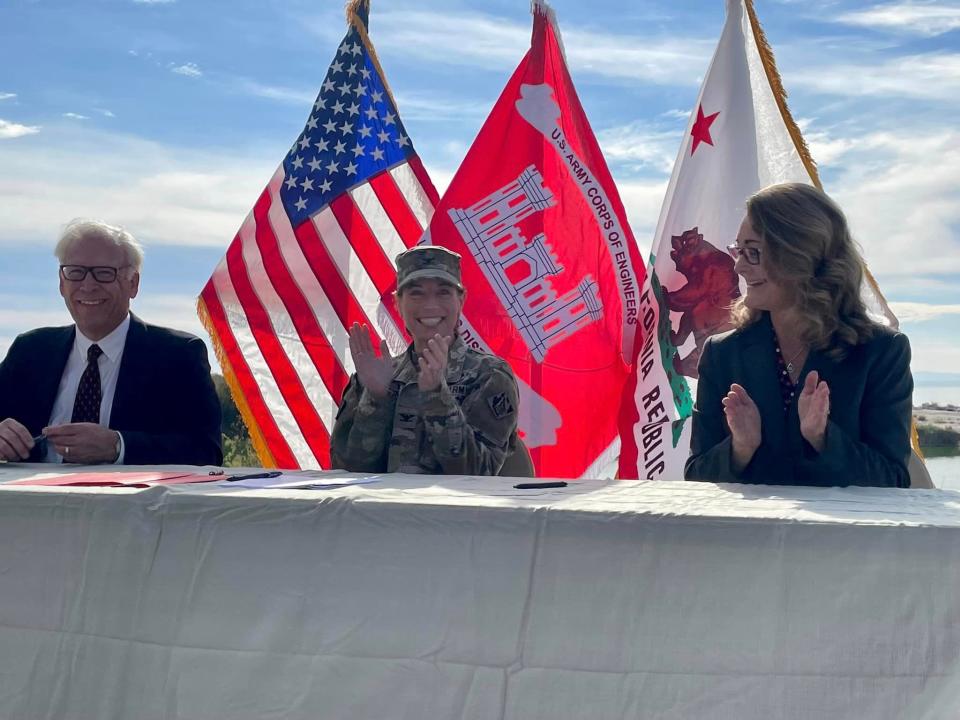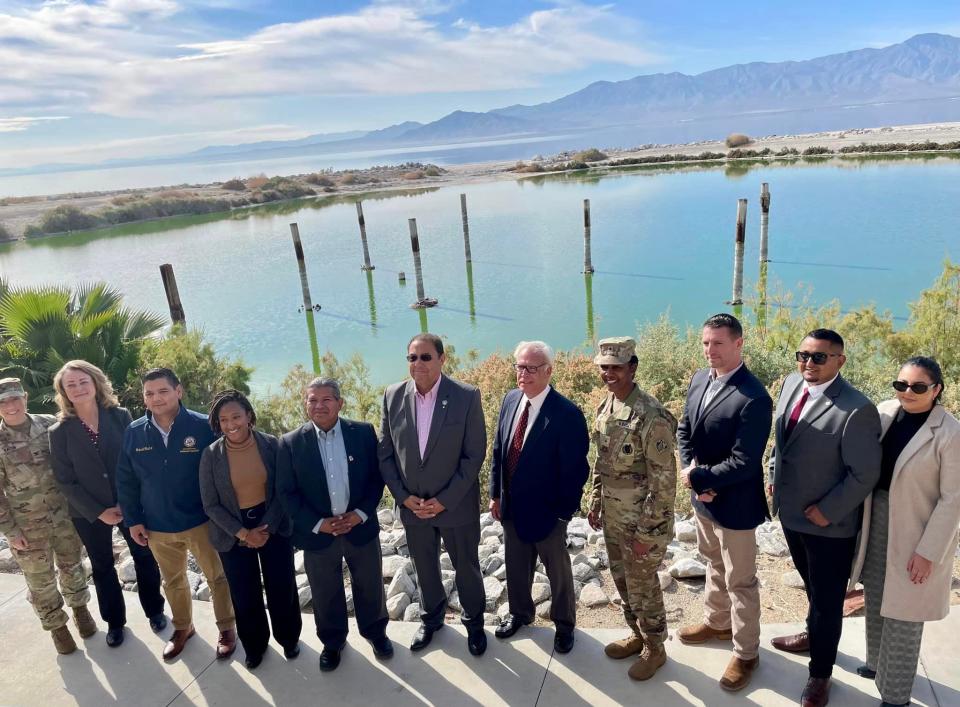Army Corps study of Salton Sea could yield billions for long-term restoration
The U.S. Army Corps of Engineers has agreed to review both short-term and long-term options for restoring the Salton Sea, which could ultimately net billions for major public works to restore the crashing ecosystem of California’s largest water body.
First up, the federal agency will, by March 1 of next year, complete streamlined federal environmental reviews of projects that are part of the state Salton Sea Management Program’s 10-year plan that is supposed to be completed by 2028, including some that are underway. They include nearly 29,000 acres of interconnected pond and wetlands habitat projects, dust suppression and native vegetation projects, and refilling former boat canals in Desert Shores.
Separately, top brass with the Army Corps’ Pacific and Los Angeles area divisions on Friday signed a cost-sharing agreement with jubilant state and regional officials for a three-year, $3 million feasibility study to determine which of more than a dozen possible large scale, engineered solutions for the Salton Sea are feasible.
Once that study is done, it could yield dramatically different results than numerous previous reports by multiple agencies over nearly 20 years, because 65% of the costs to construct any project the Corps selects could be met with federal funds.
“This is an opportunity to develop viable and innovative solutions, in collaboration with our partners, for the Salton Sea community,” said Col. Julie Balten, commander of the Corps’ Los Angeles District. “We are excited to sign the agreement as it solidifies our commitment to this community and its people to gather information, define problems and opportunities, and potentially recommend federal restoration projects at the Salton Sea.”
“This study will help chart a path forward toward the long-term restoration of the Salton Sea,” said Wade Crowfoot, California Natural Resources Secretary. “It will identify projects to improve conditions at the Sea and opens the possibility of new federal funding to deliver these projects. We’re grateful to the Army Corps of Engineers and the Salton Sea Authority for their partnership and look forward to more community engagement to help inform this effort.”

The Salton Sea is facing multiple challenges, largely due to major transfers of Colorado River water to urban areas and away from area farms that flowed into the lake. With decreased inflow, the lake is rapidly shrinking and rising in salinity. Millions of fish have died off, and thousands of acres of lakebed loaded with more than 100 years worth of pesticides, fertilizers and other potential hazards are being exposed to open air.
"I think it’s a big day, it’s an important next step in realizing some permanent changes at the sea to make people feel safer and better and good about the future of their region," said G. Patrick O’Dowd, general manager and CEO of the Salton Sea Authority, who, along with Balten and state officials, signed the agreement.
“I look at it a little differently than a conventional study, because this is essentially underwriting of a project that will be determined by the Corps of Engineers. Once the Corps goes through three years and three layers of study ... we will have an ecosystem restoration project approved by the Corps, approved by Congress and eligible for a 65% federal match,” said O’Dowd. “It’s a comprehensive study that addresses all of the permitting issues and determines an ostensibly shovel ready project for securing the appropriations."
He stressed that those funds, if successfully obtained, would cover two thirds of the costs, but the matching funds would need to be found at the state or regional levels for the remaining third.
Still, he said, "it's a good deal, it's a big step forward in really bringing in federal partners at a significant level."
O'Dowd noted that while the Bureau of Reclamation and the Department of the Interior had recently signed another agreement to provide as much as $250 million in federal funds in exchange for further damaging cuts to Colorado River supply, the Army Corps, which is the design and construction arm of the Department. of Defense, has access to far greater funds.
"It's a good deal, it's a big step forward in really bringing in federal partners at a significant level," said O'Dowd.
An Army Corps official confirmed that billions of dollars could be allocated for a project, though many steps need to be completed first.
“Yes, it’s possible, but first they need to do the study,” said Dena O’Dell, chief spokeswoman for the Corps’ Los Angeles area district. “Usually they start with a feasibility study, then go into pre-construction engineering and design, and then the last step is the construction phase. ... Once they've determined what route they’re going to go, whatever project they’re going to do, then ... it is a 65-35 cost share. But the first thing they need to do is evaluate what they’re going to do.”
O’Dell stressed that different and likely ever large amounts of monies need to be obtained for each stage, with matching funds needed. But the possibility of obtaining funds from deep-pocketed defense budgets could at last provide a realistic path for large-scale work at the vast, shimmering — but increasingly hazardous — lake.

Congressional action
The Salton Sea work was selected from multiple project study requests across the U.S., with about half a dozen typically selected each year. The Salton Sea Authority, along with California Sen. Dianne Feinstein and U.S. Rep. Raul Ruiz, both Democrats, pushing for years to win approval just for the study phase.
Finally, a resolution of the U.S. Senate Committee on Environment and Public Works authorized the Secretary of the Army to “investigate and recommend improvements for flood-risk management, ecosystem restoration and other water- and land-related resources, with a view toward restoration and protection of the environment, and improvements to public health and safety for the Salton Sea and its tributaries in Riverside, Imperial and San Diego counties” according to a joint news release.
“There is urgency in addressing the public health crisis at the Salton Sea and strengthening the all-hands-on-deck approach. Over the years, I’ve worked to build momentum and strengthen our coordinated efforts ... (including) helping fund the Army Corps’ Imperial Streams, Salton Sea and Tributaries project that will deliver the long-term solutions we need,” said Ruiz in an email.
Widely divergent proposals for how to “save” the Sea
The federal agency will have its work cut out for it, as it reviews more than a dozen projects and 11 different concepts included in a controversial draft long range plan released late Thursday by state agencies. Possible projects range from building and filling a narrow “perimeter lake” around the edge of the now-exposed lakeshore, splitting the fast-dwindling lake in two, building desalination plants along its edges, or importing water from Mexico’s Sea of Cortez 160 miles away, among others.
Possible costs range from $2.1 billion for a basic split lake proposal, not including costs of constructing a highway between the two resulting smaller lakes, to as much as $79 billion for long-distance water imports, though critics say the consultants that prepared the report grossly overestimated the import pipeline and desalination costs, and underestimated costs for projects they designed themselves.
"The process to get to where they are with the long-range plan has been somewhat fraudulent ... their long-range plan committee was really fake," said Tom Sephton, who was appointed to that committee to represent EcoMedia Compass, an environmental nonprofit working at the Salton Sea, and who also submitted a desalination proposal on behalf of his business, Sephton Water Technologies, which did not receive the highest rankings in different areas. Sephton and others on the committee were angered after being told they would not be given the opportunity to read details of different proposals, or to prepare a final report of their own, as they had expected.
"I am just waiting to see where it goes," said Sephton of the feasiblity study, "and wondering if the Army Corps is capable of being free of insider influence that has controlled the state process."
A state natural resources agency spokesman said committee members and the public would be able to comment for 45 days on the 200-plus-page report and the various projects, findings and recommendations.
Whatever project the Army Corps zeroes in on, Sephton agreed that a plus of the federal agency's work is that it could lead to hefty funding.
"I think it’s necessary for one important reason," said Sephton of the feasibility process. "If they do this with the Army Corps, then they're eligible for 65% of the costs for a project that goes through this particular National Environmental Protection Act process."
Janet Wilson is senior environment reporter for The Desert Sun, and co-authors USA Today's Climate Point. She can be reached at jwilson@gannett.com and on Twitter @janetwilson66.
This article originally appeared on Palm Springs Desert Sun: Army Corps study of Salton Sea could yield billions for restoration

